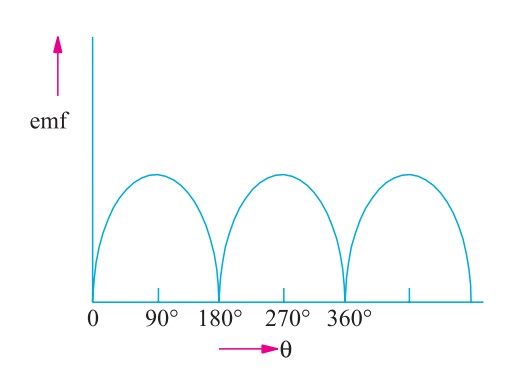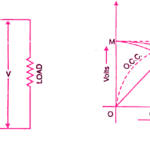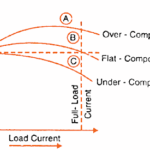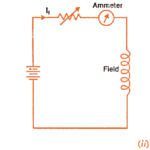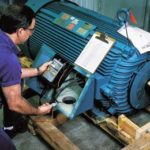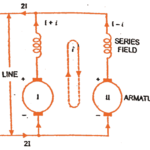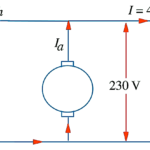A DC generator is a machine which converts mechanical energy (or power) into electrical energy (or power).
The energy conversion is based on the principle of the production of dynamically induced EMF. According to Faraday’s Laws of Electromagnetic Induction, when a moving conductor cuts magnetic flux, dynamically induced EMF is produced in the conductor. If the conductor circuit is closed, this EMF causes current to flow.
The EMF generated is different in lap wound and wave wound DC generators. So finding the amount of generated EMF is essential in the design of different types of DC generator. In this article we will derive the expression of generated EMF in DC generator.
Derivation of EMF Equation of DC Generator
Let ,
Φ = Flux/pole in weber
Z = Total number of armature conductors = No. of slots × No. of conductors/slot
P = No. of generator poles
A = No. of parallel paths in armature
N = Armature rotation in revolutions per minute (RPM)
E = EMF induced in any parallel path in armature
Generated e.m.f. $E_g=$ e.m.f. generated in any one of the parallel paths i.e. $E$.
Average e.m.f. generated/conductor $=\frac{d \Phi}{d t}$ volt $\quad(\because n=1)$
Now, flux cut/conductor in one revolution $d \Phi=\Phi P \mathrm{~Wb}$
No. of revolutions/second $=N / 60$
$\therefore$ Time for one revolution, $d t=60 / N$ second
Hence, according to Faraday’s Laws of Electromagnetic Induction,
EMF generated/conductor $=\frac{d \Phi}{d t}=\frac{\Phi P N}{60}$ volt
Number of conductors in series per parallel path = Z/A
Total EMF of generator, Eg = EMF Per Parallel Path
= EMF generated/conductor × No. of conductors in series per parallel path
Eg = $\frac{\mathrm{P} \phi \mathrm{N}}{60} \times \frac{\mathrm{Z}}{\mathrm{A}}$
$$\therefore \ Total \ Generated \ EMF, \quad \mathrm{E}_{\mathrm{g}}=\frac{\mathrm{P} \phi \mathrm{ZN}}{60 \mathrm{~A}}$$
EMF Equation a simplex wave-wound generator
For a simplex wave wound dc generator,
No. of parallel paths = 2
No. of conductors (in series) in one path = Z/2
$\therefore \quad$ E.M.F. generated $/$ path $=\frac{\Phi P N}{60} \times \frac{Z}{2}=\frac{\Phi Z P N}{120}$ volt
EMF Equation a simplex Lap-wound generator
For a simplex lap-wound generator,
No. of parallel paths = P
No. of conductors (in series) in one path = Z/P
$\therefore \quad$ E.M.F. generated $/$ path $=\frac{\Phi P N}{60} \times \frac{Z}{P}=\frac{\Phi Z N}{60}$ volt
Conclusion
In general generated e.m.f. $E_g=\frac{\Phi Z N}{60} \times\left(\frac{P}{A}\right)$ volt
A = 2 for simplex wave-winding
A = P for simplex lap-winding
Also,
$E_g=\frac{1}{2 \pi} \cdot\left(\frac{2 \pi N}{60}\right) \Phi Z\left(\frac{P}{A}\right)=\frac{\omega \Phi Z}{2 \pi}\left(\frac{P}{A}\right)$ volt $-\omega$ in rad $/ \mathrm{s}$
For a given DC machine, Z, P and A are constant. Hence, putting Ka = ZP/A, we get
$E_g=K_a \Phi N$ volts-where $N$ is in r.p.s.
Example:
A four-pole generator, having wave-wound armature winding has 51 slots, each slot containing 20 conductors. What will be the voltage generated in the machine when driven at 1500 rpm assuming the flux per pole to be 7.0 mWb ?
Solution:
$E_g=\frac{\Phi Z N}{60}\left(\frac{P}{A}\right)$ volts
Here, Φ = 7 × 10-3 Wb,
Z = 51 × 20 = 1020,
A = P = 4,
N = 1500 r.p.m.
$\therefore \quad E_g=\frac{7 \times 10^{-3} \times 1020 \times 1500}{60}\left(\frac{4}{2}\right)=178.5 \mathrm{~V}$
